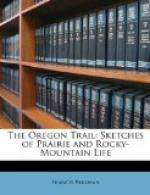On the day after, when we had stopped to rest at noon, a long train of Santa Fe wagons came up and trailed slowly past us in their picturesque procession. They belonged to a trader named Magoffin, whose brother, with a number of other men, came over and sat down around us on the grass. The news they brought was not of the most pleasing complexion. According to their accounts, the trail below was in a very dangerous state. They had repeatedly detected Indians prowling at night around their camps; and the large party which had left Bent’s Fort a few weeks previous to our own departure had been attacked, and a man named Swan, from Massachusetts, had been killed. His companions had buried the body; but when Magoffin found his grave, which was near a place called the Caches, the Indians had dug up and scalped him, and the wolves had shockingly mangled his remains. As an offset to this intelligence, they gave us the welcome information that the buffalo were numerous at a few days’ journey below.
On the next afternoon, as we moved along the bank of the river, we saw the white tops of wagons on the horizon. It was some hours before we met them, when they proved to be a train of clumsy ox-wagons, quite different from the rakish vehicles of the Santa Fe traders, and loaded with government stores for the troops. They all stopped, and the drivers gathered around us in a crowd. I thought that the whole frontier might have been ransacked in vain to furnish men worse fitted to meet the dangers of the prairie. Many of them were mere boys, fresh from the plow, and devoid of knowledge and experience. In respect to the state of the trail, they confirmed all that the Santa Fe men had told us. In passing between the Pawnee Fork and the Caches, their sentinels had fired every night at real or imaginary Indians. They said also that Ewing, a young Kentuckian in the party that had gone down before us, had shot an Indian who was prowling at evening about the camp. Some of them advised us to turn back, and others to hasten forward as fast as we could; but they all seemed in such a state of feverish anxiety, and so little capable of cool judgment, that we attached slight weight to what they said. They next gave us a more definite piece of intelligence; a large village of Arapahoes was encamped on the river below. They represented them to be quite friendly; but some distinction was to be made between a party of thirty men, traveling with oxen, which are of no value in an Indian’s eyes and a mere handful like ourselves, with a tempting band of mules and horses. This story of the Arapahoes therefore caused us some anxiety.
Just after leaving the government wagons, as Shaw and I were riding along a narrow passage between the river bank and a rough hill that pressed close upon it, we heard Tete Rouge’s voice behind us. “Hallo!” he called out; “I say, stop the cart just for a minute, will you?”




